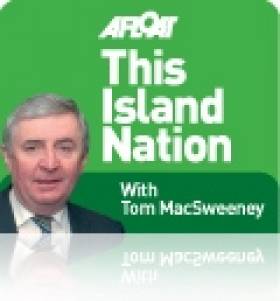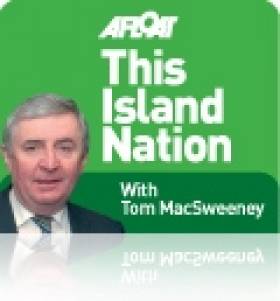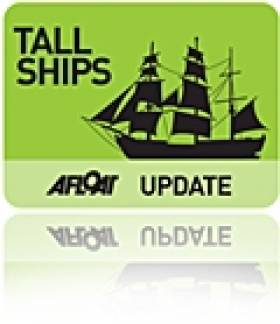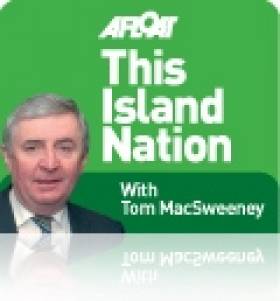Displaying items by tag: Tom MacSweeney
Caught Out by The Tide
#islandnation – Why do people still use a boat when they do not have enough basic knowledge of the movement of tides, sea conditions and the responsibility upon them that, if they go out on the water then they must be able to get back safely to shore themselves?
That question come to mind when examining the RNLI statistics for the past summer during which there were 377 calls for help to the lifeboat service. This was down slightly from 389 in the previous year, but again many of the launches were due to what the RNLI describes as "people getting caught out by the tide, problems with their vessel's engine or machinery and an increasing range of leisure marine activities."
Lifeboat crews have told me privately that there are cases where they feel people are not taking their own safety precautions, not planning sufficiently and not even carrying enough fuel in powerboats or unaware of the basic fact that tide changes can make a return journey longer than an outward one.
The RNLI always responds to calls for help, but while it is good to see more marine leisure interest and use, people must have a basic knowledge of the water if they are to use a boat. There are still too many who do not understand how to behave on the water, who do not know who has right-of-way, when not to be speeding around ports and harbours endangering or inconveniencing others, particularly moored boats and so on. Regrettably, water idiots and water hogs are plentiful in all parts of the coast.
The RNLI figures cover the period June 1 to August 31 2012. The busiest station overall in Ireland was Enniskillen which has two inshore lifeboats on Lough Erne and two Rescue Water Craft. They launched 23 times over the summer. They were followed by Dun Laoghaireand lifeboat crews in Bangor and Portrush who all launched 18 times each. The next busiest station was Baltimore in West Cork. The newly-opened lifeboat station on Lough Ree at Coosan Point in Athlone, which is currently on a twelve month trial, was also busy with nine launches this summer.
Alongside the rescues and calls for assistance there were also a number of tragedies this summer. During one week in August five lives were lost in four separate tragedies off the coasts of Cork, Mayo and Clare. Lifeboat crews were involved in searches with colleagues in the Irish Coast Guard, Garda and Navy divers, sub aqua clubs, local boats and volunteers.
Owen Medland, RNLI Training Divisional Inspector said: "This has been another busy summer for the RNLI despite the unpredictable weather. There have been some stories of incredible bravery and also some stories of devastating loss. In all cases our lifeboat volunteers have shown extreme professionalism and commitment."
There are 44 RNLI lifeboat stations in Ireland with three operating inland at Lough Erne in Enniskillen, Lough Derg in Dromineer and Lough Ree in Athlone.
OPPORTUNITIES FOR A CAREER AT SEA
The National Maritime College of Ireland will hold an open day at Ringaskiddy on Tuesday next, October 23, from 10 a.m. to 3 p.m. when representatives from international shipping companies and maritime organisations will be available to provide information about careers in the maritime industry.
There will be tours of the college including the ship simulators, sea survival centre and engineering workshops. There will also be opportunities to meet maritime companies and organisations as well as presentations on course opportunities at the NMCI. More information by Email: [email protected] or phone 021 4970607.
SALVAGE DISPUTE
The International Chamber of Shipping (ICS), which represents over 80% of the world merchant fleet, is opposing a proposal by the International Salvage Union for new charges for what the Union terms 'environmental salvage', in cases where salvors have carried out operations in respect of a ship or cargo which has presented a threat of damage to the environment. There are also suggestions by the Salvage Union for other alterations to existing salvage rules which are controversial in regard to the opposition by shipowners.
"ICS remains deeply sceptical about the proposal for a separate environmental salvage award, especially as salvage services are already generously rewarded under the present system," the Chamber says. In co-operation with the International Group of P&I Clubs, representing ship insurers, ICS leads shipowner representation on salvage issues, such as in relation to the operation of the Lloyd's Open Form (LOF) – which
The International Union of Marine Insurance has also said that the proposals need further consideration.
LOCK RESTORATION IN NEWRY AND PORTADOWN
The Newry and Portadown branch of the Inland Waterways Association has been doing great work on restoring locks 2 and 3 which had originally I am told been restored by Newry and Mourne Council in the 1990s but had fallen into disrepair.
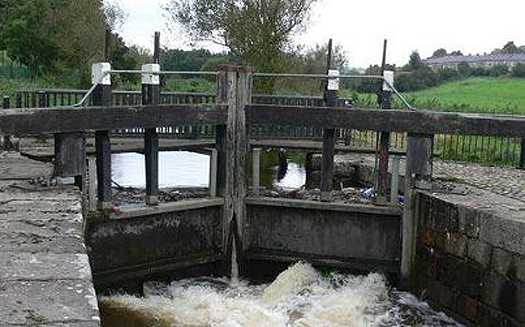
Lock restoration at Newry and Portadown. Photo: IWAI
There has been considerable support for weekend work parties and the rivers agency has also been helpful. It is good to see such dedicated voluntary commitment and there is further work I am told to be done as far as Sand's Mill including debris cleaning and there are hopes that a small boat rally will be possible in the area next month. It is some 50 years since there was boat traffic in this canal area I understand.
HOW MANY SHIPWRECKS AROUND IRELAND?
Just how many shipwrecks are there around the Irish coastline?
That question has been asked of me by readers following my report on the recovery of millions of Euros worth of silver from a shipwreck three hundred miles off the coast and for which Cork port has been used by vessels involved. This is the wreck of the SS.Gairsoppa.
The answer to the question is that there could be somewhere around 15,000 or more shipwrecks around the island of Ireland when the 32 Counties of this island are take into account. There have been official surveys and many books published about Irish shipwrecks, but there is no common agreement about the total number and, from time-to-time, more are located.
Writer Edward Bourke, a maritime historian specialising in the history of shipwrecks around the coastline has written a series of three volumes listing 7,000 wrecks.
"The listing of shipwrecks can never be complete," he said, "because information emerges from new sources regularly and new wrecks are discovered."
A Northern Ireland website, 'My Secret Northern Ireland,' which lists wrecks on that coastline answers the question with three points:
• First, the British have been a traditionally strong seafaring people and most of the routes from Britain to the rest of the world pass either to the north or the south of Ireland
• Second, the waters around the British Isles have seen much fighting at sea especially during the two world wars
• Third, the weather has contributed its own share, more so in older times when sailing ships were more susceptible to the whims of nature
The Department of Environment, Heritage and Local Government in the Republic published the 'Shipwreck Inventory of Ireland,' listing 3,000 vessels which were wrecked prior to 1946 off the coasts of Counties Louth, Meath, Dublin and Wicklow.
Karl Brady who compiled that volume of research work wrote: "As a consequence of the high level of maritime traffic in our seas and the hazards associated with seafaring, a large number of vessels have been stranded or wrecked around our coast. It is estimated that up to 15,000 shipwrecks may lie in Irish territorial waters."
The Department undertook this project to quantify Ireland's maritime heritage and create an archive of all recorded incidences of shipwrecking around our coast. This was valuable research work which, in my view, would help raise awareness generally of the maritime sphere and the historic and cultural importance of the various elements of our maritime heritage. As in other aspects of life, the current economic cutbacks may have affected the progress of this research.
In early Summer this year there was considerable interest off Schull in West Cork when the wreck of a wooden merchant ship, believed to date back to the 16th century, was discovered buried into the seabed in 10 metres of water just off the shoreline. It was located during construction work on a waste water treatment plant. The ship's cargo appeared to have included coconuts.
NO PLACE FOR COUNCILLORS
Politicians who are local councillors around the country have been finding the unexpected results of a change of regulations which the Minister for Transport introduced. Its effect, apparently, is that councillors are no longer entitled to be nominated as members of the boards of port companies. Board members are being appointed directly by the Minister according to local politician. In Cork I have been told by some of them that they think it is a blow to local democracy that what they saw as a longstanding link between the views of the public expressed through them and the port company has been lost. The port is a vital part of Cork economic life and the loss of the presence of local councillors does raise issues of democratic representation on such an important body.
Email your comments on maritime matters to : [email protected]
Follow Tom for more maritime news and comment on Twitter: @TomMacSweeney
Staying Out of the EU was Norway's Best Decision
#islandnation – In THIS ISLAND NATION this week .. How Norway preserves, protects and respects maritime tradition and its marine industries
STAYING OUT OF THE EU WAS THE BEST DECISION
I am in Norway this week where I have been looking at Europe's most diversified maritime nation. One of the most regular comments I have heard is that the country's best decision was to stay out of the European Union and maintain control over its own marine resources, from shipping to oil to fishing.
And of course they are of the Viking tradition and Ireland was well-known to those Vikings as a destination in past historic times when they raided our shores! Nowadays there is a growing Irish presence in Norway and even a GAA presence in Oslo.
Norway's overall maritime economy – an expanding cluster of industries linked to shipping, offshore oil and gas and the fishing and aquaculture industry encompasses a wide variety of products and services. It has gained worldwide respect for its shipping expertise, equipment and ability to exploit new market niches.
There is also huge respect for its maritime history, with the traditions maintained and achievements of individuals honoured presented in museums which are located at many places around the country. The shipbuilding industry comprises internationally competitive, technically-advanced small and medium-sized shipyards, focussing on ship repair and the construction of specialised vessels including ro-ros, chemical tankers, advanced fishing vessels, reefers, offshore supply ships, high-speed catamarans, cable-laying ships and seismic exploration vessels.

The latest thing in Norway, floating cabins that can be towed around
While Irish government Ministers defend what have been challenged by trade unions and other commentators as terms which favour exploration companies making finds in Irish waters to the disadvantage of the Irish people, revenues from Norwegian oil and gas activity are, amongst other benefits in taxation derived for the nation's economy, invested in a government pension fund, so that the country's petroleum wealth will benefit future generations. This fund makes long-term investments throughout the world. Called the "oil fund" its operations are well-known to the general public. "Openness and ethical considerations are cornerstones in the fund's investment strategy," government sources told me:
"Only the yield is used. The State is not allowed to use more of the oil revenues than the fund's anticipated real rate of return over time. As a result, short-term changes in oil and gas prices have little impact on budget policy."
SAILING IS BEAUTIFUL BUT DIFFERENT
Sailing the fjords of Norway is a delight. At islands dotted along the coastal areas there are mooring points driven into the rocks to which a boat can be tied and, with constant depth, there is no fear of grounding while moored. It does take a different type of mindset though, to what we Irish are used to, in sailing the boat towards the rocks! Travelling between towns and villages by boat is a regular means of transport. Most people seem to own a boat of some size.
FISHING IS THE BACKBONE
The fisheries industry is the backbone of coastal Norway. Fisheries, aquaculture and fish processing provide employment for more than 30,000 people. The annual export value of fish and fish products is around NOK 30 billion, (about €5 billion Euro) making this one of Norway's largest export sectors. "It is therefore of crucial importance to Norway to ensure sound management of living marine resources," I was told.
The fishing industry, free of the EU's restrictions, provides smoked and cured salmon, cod, monkfish and halibut. Herring and shellfish are also very popular and, unlike the controls of the EU which have sought to prevent the buying of fish straight from the boats in Irish fishing ports, in Norway you can get a bag of shrimps fresh from the fisherman's boat and enjoy it with an ice-cold beer on the quayside!
Most of the Norwegian fish catch is taken in the Norwegian Exclusive Economic Zone (EEZ) waters, covering about 2 million kilometres. There are agreements with Russia and the EU about fishing but, as with the mackerel dispute, the country strongly protects its own resources and has made this clear to the EU whose failed Common Fisheries Policy is considered a disaster that has damaged fishing within the European Union.
Seals are hunted and stocks in the East Ice are managed by the Norwegian-Russian Fisheries Commission. The North Atlantic Marine Mammal Commission (NAMMCO) is a forum for co-operation on the conservation, management and study of marine mammals in general. Minke whale harvesting is managed unilaterally by Norway and disagreement continues about this, though it seemed to me that whale meat is not as popular as it used to be.
"The over-riding goal of Norwegian management of living marine resources is to ensure their sustainable use, to ensure that the harvest is adapted to the capacity of the stocks to renew themselves. Traditionally, fish stocks have been managed in a single-species perspective. However, one species may have a considerable impact on a number of other species: for example, both cod and Norwegian spring-spawning herring feed extensively on capelin in the Barents Sea and whales and seals make heavy inroads into stocks of various fish species and organisms on which they feed. Temperature and other environmental factors also influence the migration and development of different stocks."
The ecosystem approach is increasingly being applied to fisheries management, taking into account how harvesting affects fish stocks, but also how the fisheries affect the marine environment in general, and the consequences of changes in the marine environment for living marine resources.
The fishing industry and the fisheries authorities co-operate in the formulation of the regulatory regime. However, the Minister of Fisheries takes the final decisions on management measures. Fisheries legislation is enforced both at sea and when the fish is landed. At sea, the Coast Guard is responsible for inspecting fishing vessels and their catches. Foreign vessels that are fishing in waters under Norwegian jurisdiction are also inspected.
Email your comments on maritime matters to : [email protected]
Follow Tom for more maritime news and comment on Twitter: @TomMacSweeney
In This ISLAND NATION this week .. Protect yourself against Eastern European boat thieves .... EU shambles as hundreds get free monkfish in Kilmore Quay ... Limerick invention for disabled sailing .... $31m. dollars paid for ship damage to a reef .... Coast Guard called to answer in battle for coastal radio stations' survival .... Marconi Heritage Weekend in Clifden...
SURVIVING A BREAK-IN TO YOUR BOAT
To find your boat broken into, smashed apart inside, treasured items destroyed, to discover what has been stolen, what had been a home on the water reduced to a debris-littered site of destruction, mounts up to a personal blow that can be heart-breaking. That happened to me when SEASCAPES my Sigma 33 was broken into, robbed and badly damaged on its mooring at Crosshaven. So the warning from the President of the International Association of Marine Investigators should be taken seriously – Eastern European criminal groups are targeting Ireland and are prepared to travel thousands of miles to rob Irish boats and steal maritime equipment.
Simon Lofting was quite blunt at the meeting of the Association in Cork where he said that these groups first reconnoitre an area they intend to target and then move in. Sgt. Liam Grimes of the Garda Water Unit echoed this warning, advising Irish boat-owners to improve their security to prevent marine equipment.
The theft of outboard engines has become highly organised, with the more powerful, expensive ones being particularly targeted. Crime groups, according to Simon Lofting, have created fake serial numbers for stolen engines and boats, some of which were later used in other criminal activities including drug-smuggling. Boat-owners have been advised to ensure they have photographs of their boats, engines and other equipment, with serial numbers recorded and, of course, don't keep those numbers aboard the boat itself.
After my boat was robbed the Gardai in Cobh recovered some of the items stolen and I was told that a gang had been active in Cork Harbour. Quite a lot of other equipment was recovered but, while I could identify what had come from my boat having kept records, it was not clear that other owners could do the same. I never did hear what eventually happened to those who had been apprehended and charged by the Gardai, but at least the keeping of records proved effective.
HUNDREDS GET FREE FISH IN KILMORE QUAY
The sight of hundreds of people on the quayside at Kilmore Quay taking free monkfish underlined the shambles of the European Union's Common Fisheries Policy. To land the fish broke the quota regulations imposed by desk-bound bureaucrats in Brussels who have never felt a deck heave under them on the fishing grounds. This is one of the problems with the EU. Those imposing regulations do not have sufficient practical fishing experience. Stocks must be protected. That is also in the interests of fishermen. If there are no stocks they have no future. A number of existing protection programmes were devised and implemented by fishermen. But there has not been enough public support or attention given to the industry which is more highlighted in the media at time of tragedy. The background of some of the anti-fishing industry environmental lobbying organisations should be questioned as strongly as the fishermen and fishing organisations are and their credence and level of support authenticated. While the landing of the expensive and highly-valued monkfish was a breach of the fishery laws, the reaction of the Sea Fisheries Protection Authority was predictable – prosecution of Irish fishermen. Why is the same level of prosecution not evident in other EU countries?
There is surely, another aspect of criminality – that which is against human interest. The EU has forced the dumping of fish at sea. Fish do not choose the nets they are captured in, though there can be questions about the type of nets and the location of fishing. However, the EU has talked nonsense for years as fishermen pointed out the absurdity and abuse of stocks by the forced dumping of fish and proposed systems where what is caught would be landed, with appropriate controls applying for the disposal or sale of the landings.
EU policies on fishing are a shambles, the failure for which those responsible should be brought to account. There are so many regulations damaging the fishing industry rather than helping it that they are too numerous to be even able to record them all. The Spanish industry has had too much influence, some would claim even control, of EU fishing policies for too long. The French ignore the EU and do things their own way. Once again, it is Ireland which does what the EU tells it to do.
As a renowned Irish rugby international once put it to his team in public: "Where is your pride....???"
Interview with the skipper on RTE Morning Ireland here
LIMERICK INVENTION FOR DISABLED SAILING IN EUROPEAN AWARDS
A new invention by a 23-year-old University of Limerick student to give independence to disabled sailors has been included in the global semi-finals of the 2012 James Dyson award. The 'Thadeus' chair-system enables disabled sailors to get in and out of sailing dinghies safely, independently, with more ease and dignity. 23-year-old Harry de Stacpoole who has completed a Bachelor Degree in Product Design and Technology at the University of Limerick invented 'Thadeus' after working as an instructor with disabled sailors. He felt that the only time wheelchair users were completely independent was on the water but that existing systems removed that independence. So he worked on devising a system that would provide safe transfer from a wheelchair into a sailing dinghy without assistance.
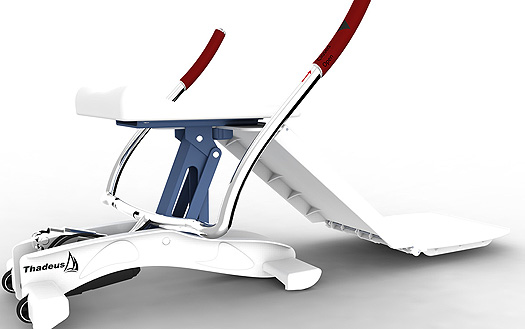
The Thadeus disabled sailing invention
"Whilst lowering themselves in the 'Thadeus' seat their legs extend and can be placed into the dinghy once the seat has been fully lowered. For reversing the process, the principles remain the same."
A number of Irish sailing clubs offered Harry the use of their facilities, dinghies and pontoons to develop his concept. Once his invention reached prototype stage, he carried out testing with sailors who had disabilities. "Their feedback was critical to the final success of Thadeus." It was on display at the London Paralympics and received a lot of interest. "The aim of Thadeus is to improve the appeal of sailing for the disabled to a wider and more inclusive range of people. I hope it will be instrumental in sailing gaining the leading edge in sport for "all-inclusiveness".
Thadeus is one of three Irish inventions that have beaten off stiff competition from over 500 entries worldwide to make the global semi-finals of the prestigious James Dyson award. It will go before an international judging panel on October 18 to select fifteen finalists from which the overall winner will be chosen on November 8.
BATTLE FOR THE FUTURE OF THE COASTAL RADIO STATIONS
I am told that Captain Chris Reynolds, Director of the Coast Guard, is expected to appear before the Oireachtas Transport Committee on October 24. It appears that Senator Mark Daly has succeeded in getting a hearing about the proposals by Coast Guard management to close Valentia and Malin Coastal Radio Stations and centralise the service in Dublin, where it was also suggested that a support station to the main Dublin centre would be located in the constituency of the Minister for Transport in Blanchardstown. With a political row on-going about the location of health facilities in the constituency of the Minister for Health - though the reasons for this are different – and concern about the downgrading of rural areas, this whole affair could assume major proportions. However it has to be said that the national media is not giving it enough attention. There are serious issues about safety at sea involved.
As far as I remember the last time the Coast Guard had to defend a proposal in this manner was back in July 2008 when Minister Noel Dempsey, then responsible for the marine and Coast Guard management were also then trying to shut down the coastal radio stations.
That was a bit of a turning-point in that proposal which was shown to have a number of shortcomings - the basis for the proposal and the facts quoted became public issues. Eventually Noel Dempsey and Coast Guard management were faced down and had to admit defeat. It will be interesting to see what happens this time, but what has been disclosed of the background to the current closure attempts through freedom of information requests raises many questions about the management proposals. October 24 should be an interesting day at the Transport Committee.
$31m. SHIP COMPENSATION TO NEW ZEALAND
Daina Shipping, a subsidiary of Greece-based Costamare, along with its insurers have agreed to pay the New Zealand government up to $31.5 million for clean-up costs after its cargo ship, Rena, ran onto the Astrolabe reef near Tauranga on a calm night last October. It spilled hundreds of tons of oil and killed thousands of sea birds in what authorities described as New Zealand's worst maritime environmental disaster.
The reef is near popular swimming and surfing beaches. $22.9 million is for oil clean-up costs incurred so far and another $8.6 million if the shipping company doesn't remove pieces of the wreck still on the reef. The New Zealand Government claims that the disaster has cost it $38.9 million. Maritime laws limited Costamare's financial liability.
MARCONI HERITAGE WEEKEND
Marconi Heritage Weekend will take place this coming weekend in Clifden, Co.Galway. It will start on Friday, October 12. The programme will include lectures and discussions about the Clifden Marconi Research Station Project, visits and walks around the locations associated with the history of the development of wireless transmissions from Clifden and reveal new insights into the little-known Letterfrack Receiving Station. The Radio Officers' Association is supporting the weekend.
Email your comments on maritime matters to : [email protected] or @TomMacSweeney on Twitter
Leading the World in Marine Research
#islandnation –In your maritime 'This Island Nation' column this week. Ireland will lead the world in maritime research ...Will you help to survey the coastline? The Titanic Captain had trouble with his navigation ... Extreme trapezing ... A new cruise opportunity, from Cork to Norway .... Screaming angling reels and more in Rosslare ...
BEAUFORT WILL LEAD WORLD RESEARCH
Work has begun on building the Beaufort Laboratory alongside the National Maritime College in Ringaskiddy, Cork Harbour, a development which will put Ireland in a leadership role in world maritime research. It is fitting that the name of the Irishman who gave the world the Beaufort windscale is attached to a laboratory that will provide a focus for research and commercial opportunities benefiting Ireland.

The Beaufort site

The Coastal and Marine Research Centre attached to UCC has for many years been doing tremendous research work of which this is its latest development with the involvement of the NMC, Cork VEC, the Hydraulics and Maritime Research Centre and the Sustainable Energy Research Group in UCC. The building is being funded by the HEA-PRTLI, Department of Communications, Energy and Natural Resources and Bord Gais and is due to be opened in the Autumn of next year. It will have a capacity for more than 130 researchers to work there and several major international companies have already indicated their interest in using its facilities.
HELP TO WATCH THE COAST
The 25th Coastwatch survey of the Irish coastline is underway and public help is being sought for this eco-audit. The survey includes shore and land use, inflow water quality and the effects on plants and animals, as well as waste, pollution and litter. "Citizen science" is how it has been described by Karen Dubsky who has co-ordinated the survey for many years. She has asked for volunteer support which can be done by downloading survey forms from the Coastwatch website to where results can also be Emailed.
"Volunteers can download the questionnaire and guide notes, choose 500 metres of shore to survey then check that area at low tide and note down the results," she said.
TITANIC CAPTAIN HAD DIFFICULTY IN PASSING NAVIGATION TESTS
The UK National Maritime Museum has released documents about seamen and the examinations they had to take in the years between 1850 and 1927. They show that the Captain of the Titanic originally failed his navigation test.
Capt. Edward John Smith, whose body was not recovered after he went down with the Titanic when it sank in 1912, failed his exams the first time round because he did not have sufficient navigating skills. But he did eventually pass the exam and receive his Masters Certificate in February 1888.
The documents provide a fascinating insight into Merchant Navy life at the turn of the 19th-Century. Effectively, they show the change in life at sea from the previous attitudes towards maritime safety towards the more modern requirements for seafarer training.
"They are a rich source of information for anybody looking to find out more about a seafaring relative or trace the career of a famous captain," says the Museum in releasing a total of 280,000 documents.
EXTREME TRAPEZING CAUSES PROTEST
The 49er skiff European Championships on Lake Garda saw a form of extreme trapezing which caused protests! The Danish crew of helmsman Allan Norregaard, an Olympic bronze medallist, crewed by Anders Thomsen, were protested for a new type of 'trapezing'. Other competitors lodged the protest when the two were seen to both 'trapeze' out of the boat at the same time when Norregaard gave the tiller to Thomsen, who took up the normal trapezing position and steered as well, while Norregarrd the normal helm, climbed onto his shoulders and trapezed out of the boat above him – a dual trapezing technique never seen before in international competitive championship sailing!
Summoned before the International Protest Jury to answer complaints, both claimed there was nothing in the sailing rules against what they described as the 'ultimate trapezing technique.'
The jury agreed!
"It works in stable conditions of 15-20 knots and Lake Garda was perfect to try it," said Norregaard.
Other teams subsequently tried the technique but failed to replicate it! The Class Association is considering whether a rule change is needed!
DIRECT FROM CORK TO NORWAY
Cruising has become very popular but direct opportunities from Ireland have been limited, though they are increasing, with a 'first' to a new destination to be launched next year, direct from Cobh in Cork Harbour to Norway. The Port of Cork Company, Royal Caribbean and the Lee Travel agency are to announce details on Thursday, September 27 of the 12-day Norwegian Fjords Cruise.
INTERNATIONAL ENERGY CONFERENCE FOR DUBLIN
The 4th International Conference and Exhibition on Ocean Energy will be held from October 17 to October 19 in Dublin. Sixty-five international exhibitors are so far booked for the exhibition which will be held in the Dublin Convention Centre. Major speakers are also lined-up for the event.
ROSSLARE MARITIME ENTHUSIASTS
Rosslare Maritime Enthusiasts have taken over the former Tourist Office on the main road from Rosslare Harbour to Kilrane. The group have begun transforming the building into what will be called 'The Rosslare Harbour Maritime Heritage Centre.' The group, formed in 2004, has published two books and a third is nearing completion.
"We have previously held an annual maritime exhibition during the Rosslare Harbour summer festival but have been looking for a suitable permanent home to establish what we believe will be a great addition to the community and County Wexford," they say.
ROSSLARE'S TOP TRIGGER
Also in Rosslare an "Uptide Girl," an English angling writer and a top triggerfish, combined in the boat name, the writer Gordon Thornes and the 2.32kg. triggerfish to become the Inland Fisheries Ireland 'Catch of the Week' during the Rosslare Small Boats festival which proved to be a great success again this year despite challenging weather conditions for the competition.

For the third time in the last four years 'Screaming Reels' from Rosie's Sea Angling Club in Cork won the competition with 24 different species of fish, beating 28 other boats from the UK. Fishing was very good with 30 different species recorded.
Silver Millions, Piracy Hostage Couple & World Cup Sailing Students
In this week's This Island Nation Column, millions in silver to be recovered off Cork, a piracy hostage couple sailing again, five million dollars to recover a schooner and reports about world cup students and an offer to survey whales.
RECOVERING SILVER MILLIONS OFF CORK
A ship engaged in wreck recovery worth millions of pounds sterling docked in Cork Harbour in the past week to change crew, take on fuel and supplies, then sailed again for a location 300 miles off the Irish coast. Odyssey Marine Exploration has so far recovered 48 tonnes of silver, believed to be worth about stg£24 million from the site to where the vessel, the Seabed Worker returned. Lying on the seabed there is the British India Steam Navigation Company's 412-foot steel-hulled cargo ship Gairsoppa which was part of a convoy during World War Two, returning from India to Britain with a cargo of silver ingots and pig iron. In a heavy storm on February 16, 1941 and running low on coal off the coast of Ireland she had to leave the convoy in an attempt to reach Galway for safety. But a German Air Force plane spotted her and directed a U-Boat to attack. The submarine sank her and killed all of the crew except six who got away in a lifeboat and eventually reached Cornwall, but two of those died trying to get ashore.
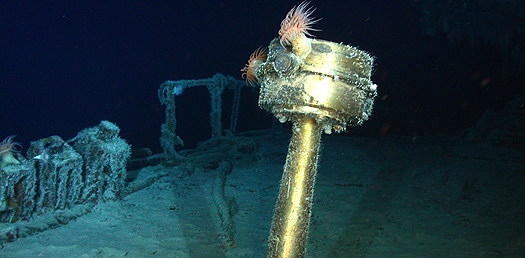
The wreck of the Gairsoppa
Odyssey is recovering the silver under contract with the UK Department for Transport. The total value is unclear but some estimates put it around stg£120 million, though there is not confirmation of this figure. Odyssey, a USA company, bears the risk of search and recovery and can retain 80% of the net value of what is recovered after expenses. The shipwreck is three miles below the surface and the company has said that the recovery operation is one of the deepest and heaviest attempted. No materials recovered from the shipwreck site were landed during the port call to Cork.
"Making crew change in Ireland instead of the UK allows us to spend additional working days on the site. As the weather conditions tend to become less friendly in the North Atlantic as we get closer to October, every additional day of operations is important," said Mark Gordon, Odyssey President. "The processing of the silver so far delivered remains on schedule with the first portion available for sale this month If silver prices continue to increase, it will significantly boost the value of this project."
HOSTAGE COUPLE SAIL AGAIN
The English coupled held hostage for more than a year by Somali pirates have set sail on the same yacht again – intending to finish the round-the-world trip from which they were captured off the Seychelles in 2009. The release of Paul and Rachel Chandler, from Tunbridge Wells, was arranged in November 2010.after 13 months in captivity. They have restored their 38-foot yacht, Lynn Rival, which was found drifting in the Indian Ocean after their capture. They said their ordeal had not put them off sailing.
DROP IN PIRACY
The number of pirate attacks on shipping off Somalia has fallen sharply in the first half of this year according to the International Maritime Bureau. 177 incidents were reported to the IMB Piracy Reporting Centre in the first six months of this year, compared to 266 in 2011. But IMB Director Captain Pottengal Mukundan said that there was a worrying increase in attacks on shipping in the Gulf of Guinea.

Photo from the EU Naval Force Somalia shows the capture of a suspected pirate boat off Somalia
Six Somalian pirates have been found guilty of hijacking the French vessel Le Ponant in 2008 and sentenced to a total of 24 years in prison by a court in Paris.
DUBLIN-CORK AXIS FOR WORLD CUP
There is a Dublin-Cork axis to Ireland's attempt to win the Student World Sailing Cup in La Rochelle, France, from October 27 to November 3. University College Dublin's sailing team will represent Ireland but the ten-strong team includes three Cork sailors and will be coached by another Cork sailor. The UCD students won the right to represent Ireland at the Student National Championships in Dun Laoghaire in March. The Cork trio continue Southern sailing involvement in the world cup for several years past but the team is composed also of sailors from all over the country including Antrim, Down, Mayo, Sligo, Wexford and Waterford. Team Captain is Cathal Leigh Doyle; Aidan McLavery from Belgooly is Skipper; Isabella Morehead from Rochestown and Ben Fusco from Kinsale are the other two Cork sailors on the team which includes Barry McCartin, David Fitzgerald, Simon Doran, Theo Murphy, Alyson Rumball and Ellen Cahill.
Reigning student world champions are Euromed Arthur Loyd of France. The UCD team will be trained by Cork sailor Nicholas O'Leary, brother of Olympian Peter O'Leary and past Student Yachting World Cup competitors John Downey and Marty O'Leary. Ireland last won the Cup in 2008, another Cork triumph.
SEEKING WHALE VOLUNTEERS
The Irish Whale and Dolphin Group is looking for volunteers for surveying aboard their Celtic Mist "who have cetacean survey experience (land or sea based) and who have or are prepared to obtain an ENG11 Marine Medical certificate and an STCW95 Sea Survival Certificate," the Group says. Volunteers will have to pay their own expenses to join the vessel and obtain the certificates. Accommodation and meals will be provided free-of-charge on board. Surveys will typically last for 2-3 weeks.
"While we appreciate that participation will involve a cost to volunteers, it will also provide an excellent opportunity for budding cetacean biologists and more seasoned surveyors to gain experience in offshore cetacean surveys," the IWDG says. The Group will provide information and guidance on survey techniques and equipment for data collection.
• If you are interested email [email protected]
AMUNDSEN SCHOONER TO SAIL HOME
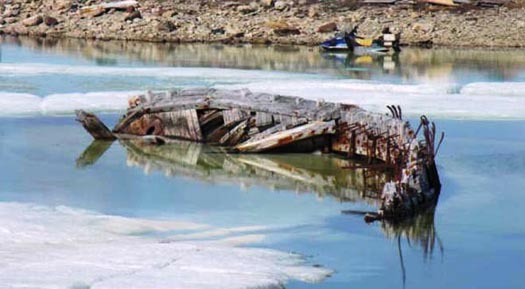
A Norwegian group is hoping to raise over five million dollars to raise the 200-tonne schooner sailed by legendary Norwegian explorer Roald Amundsen and return it to Norway. The Maud has lain partially submerged in Cambridge Bay in Canada since sinking in 1930.
FIRST FOR DINGLE
The first Maritime Heritage Weekend in Dingle, Co.Kerry, will be held during the October Bank Holiday Weekend October 27-29. It will commemorate Michael Long and his contribution to marine biology. Born in 1889, he died in 1980 and was a publican in Dingle (John Benny's Pub) who took a great interest in the flora and fauna of the area and all things related to the marine. "He catalogued many specimens brought to his premises and encouraged many others to take an interest in their surroundings on land and at sea and we are delighted to honour him at this event," say the organisers.
The Future of Shipping Fuels, Ireland's last Engineless Sailing Schooner & Lots More
#thisislandnation – The future of shipping fuels, Ireland's last engineless sailing schooner, galley slaves in Russia, locating the newest lifeboats and GPS disruption all in This Island Nation this week.
A FUTURE IN ALGAE
The United States Navy uses 80,000 barrels of oil a day. The total fuel consumption of world shipping is not known, but several shipping lines have introduced 'slow steaming' to reduce oil usage because of increasing costs. Maersk, one of the world's biggest shipping companies and the US Navy have been jointly exploring the possibility of developing 'green fuels'. Maersk has 1,300 vessels in its fleet. This year the Maersk Kalmar, a 300 metre-long container vessel completed a 6,500 nautical-mile voyage from Germany to India burning 30 tonnes of a fuel developed from algae in an its auxiliary engines under test by engineers. Fuel properties were similar to marine gas oil according to Maersk engineers carrying out experiments on board.
Two years ago the US Navy tested its first algae-based fuel and has been engaged in research for several years. In the UK researchers at the University of Bath have been experimenting on the commercial production of biodiesel from algae. Maersk, a Danish company, has been given a grant of 112 million Kroner by the Danish National Advanced Technology Foundation for continuing research into the production of bio-based fuels for the global shipping industry.
IRELAND'S LAST SAILING SCHOONER
The last sailing schooner to trade in Irish waters was the Brooklands which operated without an engine and was a familiar sight in Cork Harbour as she emerged from her home port in the north-eastern corner of the harbour, heading for the open sea. The Creenan family owned Brooklands and sailed her out of Ballinacurra which closed as a port for commercial operations in the early 60s. Brooklands and the Creenans will never be forgotten in the maritime annals of Cork Harbour.
She was originally known as the Susan Vittery and traded along the Irish South coast. At the age of 43 John Creenan of Ballinacurra became her Master. In July of 1920 her name was changed to Brooklands. She was bought by John Creenan for £1,300 in the currency of the time and noted as a three-masted double topsail schooner, capable of carrying 226 tons of cargo.
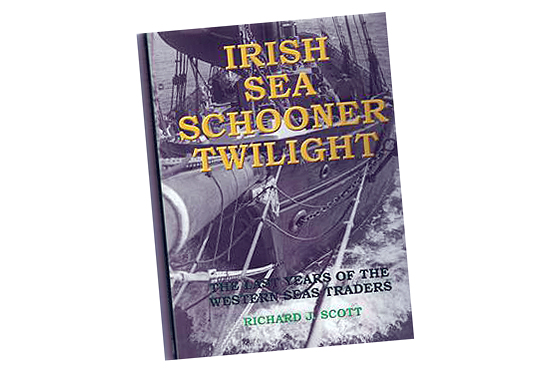
Richard Scott's new book on the last of the Western Sea Traders
"Captain John liked her and reckoned on making her pay, even without an engine," writes Richard Scott in a new book which was launched in Creenan's family pub in Ballinacurra that was packed with a big attendance from all over the country for the occasion. "Irish Sea Schooner Twilight" is the story of the Western Seas Traders and their last years. These were the vessels which saw the end of sailing traders, as steam and engine power replaced them. They traded coastwise around the Bristol Channel, some across to France, mostly between Ireland and Britain and began to disappear from the seas around the late 50s. Life was tough and dangerous for the seafarers who sailed these vessels.
Dick Scott shipped aboard Brooklands and was the man who wrote the definitive book about the Galway Hookers. He died at the age of 81, so this new book for which he had carried out meticulous research over very many years is also a posthumous tribute to a great marine writer.
He recalls sailing the ship up to Penrose Quay in Cork City to discharge cargo: "Christie knew his vessel well and every detail of the narrows past Fort Camden and Carlisle. We were on the living deck of a remarkable schooner that had first sailed these same waters over ninety years earlier. After discharging cargo the Skipper of a steam collier offered Christie a tow downriver. Off Whitepoint we heaved in our warp as our friends on the collier blew farewell on their ship's hooter and we were on our own, sailing past Cobh, surprising a fleet of yachts as they gave way for the passage of this great sailing vessel, Christie at the wheel, calmly taking the Brooklands towards Ballinacurra where we were to load silica clay for transport to Dublin.'
The days of being without an engine meant that, without a favourable wind, they had to anchor for the night before they could get to Ballinacurra!
"Off the north east corner of Great Island we rounded up at the Crab Hole and dropped anchor for the night. Next day we took assistance from a small motorboat to work the tide two miles up the Ballinacurra River narrows to our berth near Bennett's malt stores as Cecil Gregory's Arklow schooner Venturer passed outward bound."
What an amazing vision of other times, two schooners passing each other in the river between Ballinacurra and East Ferry.
The book is published by Black Dwarf Publications.
PUTIN - BOSS, GALLEY SLAVE AND FOUR MASSIVE YACHTS!
Russian President Vladimir Putin has compared ruling Russia to being a "galley slave", but his job comes with four luxury yachts, top of the range of which has five decks, a huge bathroom in marble, jacuzzis and other opulence. Another yacht of the fleet is 53.7 metres long has a spa pool and a wine cellar.
Russian Opposition Leader, Boris Nemtsov, said that it was "no wonder that Putin wanted to hang onto the Presidency!" The office also has a fleet of 58 planes and 20 homes. Nemtsov has listed the details in a report titled, rather ironically, "The Life of a Galley Slave!"
BALTIMORE NAMING
Baltimore's new lifeboat, RNLB Alan Massey, will be named and dedicated at a ceremony in the West Cork village on Saturday afternoon, September 22.
On Tuesday, September 25, at its Poole headquarters in the UK the RNLI will reveal its most advanced class of lifeboat – the Shannon, the first RNLI all-weather lifeboat to be powered by water jets instead of propellers and capable of a speed of 25 knots - 50% faster than the lifeboats it replaces. The Shannon class follows a 45-year tradition of naming RNLI lifeboats after rivers or stretches of water. This is the first time that the name of an Irish river has been used.
{youtube}ETSYbhGGlxM{/youtube}
It is planned to build fifty of the new boats over the next ten years. It will improve the safety and welfare of the volunteer crews, with shock-absorbing seats and computer monitoring and operating system. The RNLI has so far named only UK stations to receive Shannon class boats. They are: Dungeness, Hoylake, Ilfracombe, Llandudno, Lowestoft, Montrose, Scarborough, Skegness, Selsey, St Ives, and Swanage. Other stations are to be confirmed.
SOLAR GPS DISRUPTION
The Chairman of the international shipping offers' union, Nautilus, has warned that GPS electronic navigation could be lost for "months at a time" during the next two years. Ulrich Jurgens claims that high levels of solar activity could add to the problems already being experienced from attempts to jam GPS signals, which are being increasingly reported by criminal gangs involved in drug-running trying to frustrate security forces. Mariners could suddenly be looking at blank electronic screens, he has said, advising that "paperless vessels," without older-style charts, could be "lost at sea," unable to identify their position if depending totally on electronic navigation.
{youtube}-vljnLaBOlo{/youtube}
An amazing sea rescue, NAB-ing change, UK politicians support what Ireland’s will not, sailing in Galway and Mayo and much more in your TIN this week…
An amazing sea rescue, NAB-ing change, UK politicians support what Ireland's will not, sailing in Galway and Mayo and much more in your TIN this week.....
AMAZING SEA RESCUE
A 31-year-old seafarer has survived ten hours of swimming after ships in the Atlantic Ocean 525 miles offshore shouting to be rescued. It has been described as one of the most amazing sea survival and rescue stores. He fell off his ship after feeling faint when he leaned against a railing but blacked out, collapsed and fell overboard. The crew of the Maersk Bintan did not miss him for 2 hours after he had fallen off at 0715 hours. At that stage Tanawoot Pratoom, who came back to consciousness when he hit the water, had been swimming after ships he saw and shouting for help. The ships' crew had called a distress alert. Five vessels as well as a search-and-rescue plane were involved and the US Coast Guard was using drift simulation technology to locate his position. His own vessel doubled back on its course. He was spotted by another vessel involved in the search, the bulk carrier, Stalo. After ten hours he was pulled from the water by crewmates of his own ship. He said he had followed safety procedures by removing his boots and overalls in the water and had spent the ten hours swimming towards passing ships until he was sighted. His ship was en route from Panama to Algeciras where the seafarer was repatriated to his home in Thailand. He is married and has two children, an 8-year-old daughter and a three-month old son.
REFITTING THE NAB

The NAB Tower
The NAB Tower is a vital aid to navigation in the Solent but the structure has been deteriorating and is being restored by Trinity House, the UK lighthouse authority. It was originally built as a British defensive structure for the Admiralty in 1918 and has been used as a lighthouse since 1920 replacing the previous NAB Lightvessel. It was staffed by Lightkeepers until automation in 1983. At present the helicopter pad atop the lighthouse cannot be used and boat access has been difficult due to the deteriorating condition of the external superstructure. Trinity House is to extend the lifespan of the NAB Tower by up to 50 years. The height will be reduced and all external steel and cladding will be replaced by concrete. Work is scheduled to be completed in the summer of next year. It will be suspended during the winter due to difficult seasonal conditions.
YOLING IN GALWAY
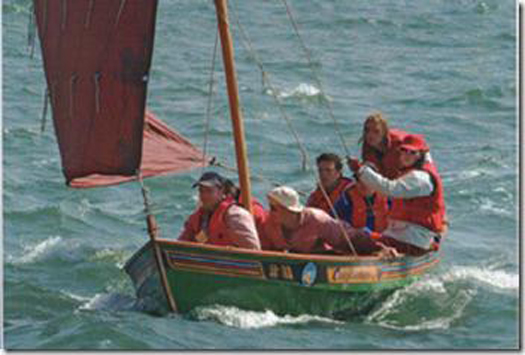
The Ness Yoal
The little beauty pictured here visited Galway Bay Sailing Club from France, but originated in Norway, were exported to the Shetlands and are now active in France, demonstrating the great linkage internationally through traditional sailing boats. The 'Yoling Club Peillac' is based in the village of Peillac, in South-East Brittany. It was created to promote traditional sailing amongst youth and especially the practice of navigation on the Ness Yoals, following the construction of three of these boats in 2000. The club aims to connect with other associations sharing similar interests in 'sail and oar' boats and to encourage the construction of traditional yachts and organises events to promote cultural heritage related to traditional sailing.
Ness yoals are wooden open boats of 6.90 m in length, rigged with a sail to the third of mahogany colour. The crew is composed of 7 people (six rowers and a coxswain). The Ness Yoals originated in Norway hundreds of years ago and were exported to the Shetland islands in Scotland, where it has a special place in the history of inshore fishing. It was considered a very seaworthy vessel and the seamanship of the men who crewed them, made the
difference between survival and starvation for many families there. Despite the development of commercial fishing, which favoured larger-decked boats, the Yoal has survived into the 21st century, due to the interest in Yoal-rowing as a sport and the craftsmanship of boat-builders like Tommy Isbister and Ian Best who still produce these craft.
UK POLITICIANS BACK SAIL TRAINING
Renowned naval architect Colin Mudie has designed a proposed new UK sail training flagship. Riding on the tide of successfully staging the Olympics and the Diamond Jubilee celebration a charitable trust has been set up called – UK Flagship – to promote the concept of a 650-foot tall ship which would be the largest and most advanced square-rigged vessel in the world. It is envisaged as a sail training ship with the additional role of being a 'floating ambassador' for the UK promoting trade and scientific research, with facilities aboard including conference rooms, oceanography and marine biological study resources and could carry up to 200 trainees. The cost is put at stg£80m., to be raised without State support. Launch of the ship is targeted for 2016 and stg£15m. has already been raised according to the backers, of which the Principal Trustee is Royal Navy Rear Admiral David Bawtree. UK sailing journalist Libby Purves is also involved in the project. The Daily Mail
Newspaper has launched a fundraising campaign for the vessel.
While not allocating any funding, leading UK politicians have pledged support and backed the project, showing at least an interest in sail training which their Irish counterparts lack. Deputy UK Prime Minister Nick Clegg said the project provided "a brilliant opportunity to promote the marine world and life at sea" while the UK Labour Party Leader, Ed Milliband, said it was a cause which deserved support because of its aim of "giving opportunity to youth."
The tall ship will feature four masts acting also as solar panels. Colin Mudie designed the sail training ships Royalist and Lord Nelson.
Operating tall ships is difficult in current economic times although the South African Government approved the conversion of a former research vessel by the country's Maritime Safety Authority to carry 50 cadets for sea training. The country has less than 2,400 seafarers and the government has adopted a policy to increase annual officer cadet intake for training which at present is 120 per year.
MAYO SAILING CLUB
When in Mulrany, Co.Mayo, this summer I enjoyed the idyllic view of Clew Bay and the 365 islands, one for each day of the year as local people proudly claim. Mayo Sailing Club was founded in 1982 and has this area as its immediate sailing grounds.
This is a thriving vibrant club, based at Westport, with a diverse range of sailing activities throughout the season - cruiser racing on Thursday nights, junior and senior dinghy racing on Tuesdays and cruising voyages.
Thirty-six trainee sailors from the club had an overnight sailing trip from Rosmoney Pier to Inishoo Island in Clew bay. It concluded the Adventure Module of the ISA Small Boat Sailing Scheme and also marked the end of the Junior Sailing course. The return voyage involved the trainees sailing a challenging beat home on a route through around many of the islands before arriving at Mayo Sailing Club.
FISHING LEADER HONOURED
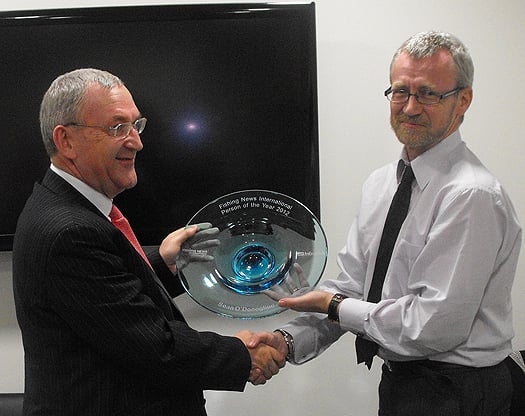
In London this week Sean O'Donoghue CEO of the Killybegs Fishermen's Organisation was presented with the Fishing News International magazine's Person of the Year award. The presentation was made by IntraFish Fishing Publications Editor Cormac Burke who is originally from Killybegs.
Rambler Crew Thankful, A Story of Two Vessels, Our Paralympians and Cork's New Pilot Boat
The Rambler Crew thank Valentia Radio for saving their lives in the Fastnet Race, but Coast Guard management wants to shut the station .... My story of two vessels ... John Twomey's Parlaympian achievements ... Cork gets a new Pilot Boat and ... trying to make ship-boarding pilot ladders safer ... There's a lot about boats in this week's TIN ..... Read on ....
SAVING LIVES MATTERS MOST – NOT FINANCIAL CUTBACKS
August 15 this year marked a very special day for the crew of the yacht Rambler 100 – they were still alive and they celebrated that fact – and they sent from New York an Email to the staff of Valentia Radio Coastal Station in Kerry. Coast Guard management in Dublin has a proposal to shut down the station and transfer its work to Dublin, to the constituency of the Minister for Transport, as a support station to the main Dublin base!
On August 15 the Rambler 100 crew Emailed to the staff at Valentia Island Maritime Radio Station:
"Today marks the one-year anniversary of our unfortunate accident during the Fastnet Race. Each Rambler crew member has his own story of what happened during this time of distress, however, the one thing that we share is the gratitude we feel for the Valentia Island Coast Guard. The professionalism of the Valentia crew and the diligence in alerting all authorities for our successful rescue is the reason we are here to share in the celebration of survival today. Tonight at 5.42 p.m. New York time the Rambler team will gather together and raise our glass to the sea and send out our thanks to our new friends in Ireland. Gratefully yours, Wendy, George and the Rambler 100 Crew."
Not much more needs to be said about the importance of Valentia Island Coastal Radio Station and its continued operation. It has a long history of saving life at sea in addition to its other operations.
I have asked for an interview with the Director of the Coast Guard Chris Reynolds, to find out exactly what is going on with the management proposals and why they want to centralise operations in Dublin. One proposal is that a support base to the national centre in Dublin should be located Blanchardstown, which just happens to be in the constituency of Minister for Transport Leo Varadakar who will have the final decision to make on the future of the coastal radio stations at Valentia and Malin and who has already indicated that "tough" decisions will be taken.
Again, the question has to be raised, as it was when then Minister Dempsey sought to close Waterford SAR rescue station – How much is a life worth?
TWO BOATS – TWO STORIES
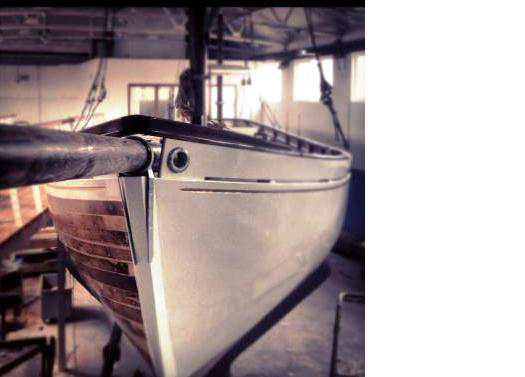
Asgard I pictured above, Celtic Mist in main image
Two boats, part of the Irish maritime scene in years past, are back in public – Asgard 1 and Celtic Mist – one ashore, the other afloat.
I was in the National Museum at Collins Barracks in Dublin when the historic ketch of Erskine and Mollie Childers went on exhibition after a five-year restoration project. It will be a permanent reminder of how the marine sphere was central to the formation of this Republic. Asgard looks superb. There was a lot of controversy over whether she should be restored or put to sea again, but the right decision has been made to conserve her ashore. The exhibition is open free-of-charge and worth seeing.
The second vessel, Celtic Mist, is the motor-sailing ketch of Charlie Haughey which his family donated to the Irish Whale and Dolphin Group. I was asked to re-dedicate it to its new role as a research vessel and did so on Sunday at Kilrush Marina, where hundreds watched the ceremony. I talked to Conor Haughey who told me: "They have rejuvenated her. She was getting old and tired and it would have been a shame if she rotted away rather than going to sea again. The boat was very important to my father. It has great family memories."
Onboard, Charles Haughey's cabin has been dismantled, including the bath and double berth and several bunks built instead for researchers who will track whales and dolphins and carry out other maritime research. Much of the eight-month refurbishment work was done by IWDG volunteers, with some contractors and financial assistance from the Clare Leader organisation and other supporters.
Despite all the controversy surrounding Haughey, as IWDG Director Simon Berrow said, getting the boat was a major benefit and came in the 21st year of its existence. In government Haughey had declared Ireland's waters a whale and dolphin sanctuary and Dr.Berrow said this should be followed by a
similar "pan-European designation" of EU waters. The Celtic Mist will provide a platform for finding out more about whales and other marine life off Ireland, he said.
JOHN TWOMEY AND THE IRISH PARALYMPIAN SAILORS

Irish Sonar Team
Kinsale Yacht Club member John Twomey is leading his crew into his tenth consecutive Paralympics, a magnificent achievement for the 57-year-old sailor. He will Skipper the Sonar, Ireland's only sailing entry, with crew Anthony Hegarty and Ian Costelloe. Sailing will be in the testing waters of Weymouth Bay on the south coast of England where the Olympic events were also held.
For the past three and a half decades he has been one of Ireland's most consistent and successful performers at the Paralympic Games. John is already the holder of Paralympic medals, won prior to his sailing career in the discus event - bronze in 1984 and gold at Seoul 1988. He also competed in table tennis before his transition to sailing, winning silver in the team event at Arnhem in 1980. Before moving to the three-man Sonar keelboat he sailed with Amy Kelleher in the mixed SKUD18 event at Beijing 2008, finishing tenth with a score of 75 points.
In preparing for this year's Paralympic John, Anthony and Ian were 7th in the World Disabled Sailing Championships in Florida and have been practising intensively off Kinsale over the past few weeks.
I met him at Kinsale YC and he was hopeful about their prospects:
"Tough waters in Weymouth, but with the experience of the past few months, particularly in the world championships we are well prepared."
John is from Ballinhassig, has represented Ireland more times than any other Olympic or Paralympic athlete. He is involved in sailing courses in Kinsale for people with disabilities where up to 30 sailors with a wide range of physical, intellectual and sensory disabilities go sailing every Saturday.
In Paralympic Sailing, three medal events feature one, two and three sailors per boat, respectively. All events consist of nine separate races with one point for first, two for second and so on, the same as in Olympic sailing. The winner has the lowest points total at the end of the nine races.
John's crew mates are 42-year-old Anthony from Mallow and 24-year-old Ian from Killorglin in County Kerry. Both are both amputees. John introduced Anthony to sailing seven years ago. He works as a software developer for Core International and has represented Ireland on several occasions. He is also a member of Kinsale Yacht Club.
Ian also sails out of Kinsale YC and will be making his first appearance at the Paralympic Games.
Paralympics Ireland CEO and Chef de Mission for the Irish Team, Liam Harbison, said there has been tremendous preparation, co-ordination and management of the Irish Team. "It's time for us to make a return on the faith and investment placed in us – we aim to deliver."

From left: John Twomey, Ian Costelloe and Anthony Hegarty.
NEW PILOT BOAT IN CORK
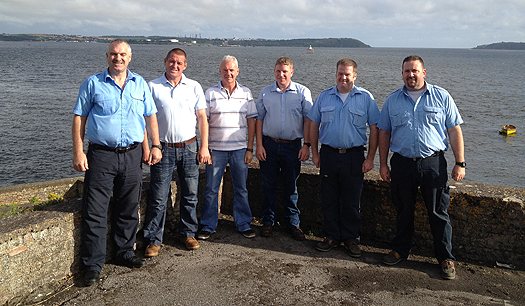
Cork Pilot Boat Crew
Cork Port has a new pilot boat. 'Failte' was built by Safehaven Marine and replaces 'Sonia' which has been in service for 14 years. Safehaven Marine is a Cork -based company, employing 25 staff in Little Island and Youghal. Since the company was founded in 1998. They have supplied pilot boats to countries from Scandinavia to the Middle East and are one of Europe's leading manufacturers of GRP pilot boat.
There are eight full-time crew, six of them pictured here – L to R: Ron Randalls, Carl Randalls, Gerry Moran, George Norris, Con Crowley and Keith Ryan. (Two were on holiday when the photo was taken.) The boat is an Interceptor 48 with two Volvo D13 engines, 600 hp each.
Cork pilot boats undertake in excess of 3,000 services per annum to vessels of all types including cruise ships and cargo vessels, according to the port company.
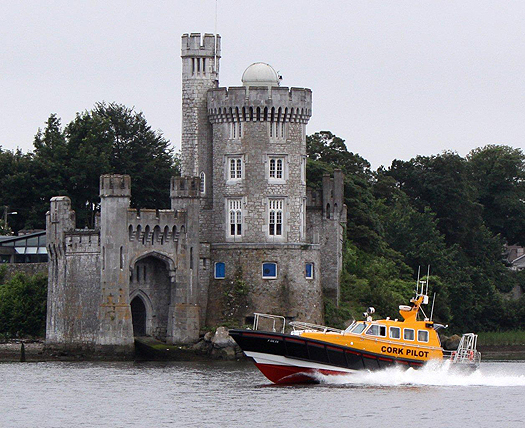
MAKING PILOTING SAFER
The International Maritime Pilots' Association and the International Chamber of Shipping have joined forces to update a brochure aimed at shipping companies and seafarers to ensure that ladders used for pilot transfers are safe and always rigged correctly.
The revised brochure – 'Shipping Industry Guidance on Pilot Transfer Arrangements' – is supported by a wide range of other international shipping bodies. It takes account of the latest amendments to the Safety of Life at Sea Convention (SOLAS) concerning pilot ladders, which came into effect on 1 July 2012.
IMPA Secretary General, Nick Cutmore, said: "Pilots continue to lose their lives as a result of accidents while boarding or disembarking from ships, and many more have been seriously injured."
ICS Secretary General, Peter Hinchliffe, added: "Some common causes of accidents still appear to be defects in the structure of the ladder treads or ropes, or a lack of a proper securing of the ladder to the ship."
An electronic copy of the IMPA/ICS brochure can be downloaded from the IMPA and ICS websites.
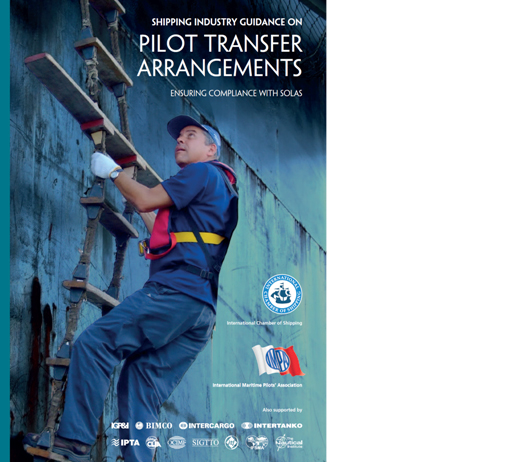
New Pilot Boarding Advice
--------------------------------------------------------------------------------------------------------
Email your comments on items in TIN develop maritime discussion to: [email protected]
Follow me for more maritime news and comment on Twitter: @TomMacSweeney
And on Facebook – THIS ISLAND NATION page
Wait Almost Over for Celtic Mist Relaunch
#CELTIC MIST - The wait is almost over for the relaunch of the Celtic Mist, as The Irish Times reports on the completion of its 'make-under'.
Tomorrow 12 August will see the ketch formerly sailed by late Taoiseach Charles Haughey officially begin its new life as a research vessel for the Irish Whale and Dolphin Group (IWDG), as previously reported on Afloat.ie.
Apart from extensive work to the interior of the vessel to transform crew accommodation and make space for scientific instruments, the hull of the Celtic Mist has been beautifully repainted in different shades of blue, with details such as a dolphin on its bow and a fun whale along the beam contributed by Kerry artist Michael O'Leary.
Among the new gizmos installed on the yacht - which sailed a leg of last year's Tall Ships Races - is an automatic identification system that will allow internet users to track its position online.
Conor Haughey, whose family gifted the yacht to the IWDG for its marine wildlife conservation work, is expected to attend the relaunch ceremony at Kilrush marina at 2pm, hosted by Afloat.ie's own Tom MacSweeney with a blessing by Fr Michael Sheedy of Kilrush.
Magnificent Asgard, Commercial Fishermen and a Sticky Situation
ASGARD rises again .. Can you help to find goose barnacles? ... Irish brothers wrap up the 18s in Scotland... Commercial fishermen want bass fisheries re-opened.... The weather hasn't really been so bad – do you believe that? The Channel Tunnel buys ferries ... Lusitania artefacts are assigned to the States and the oceans are saving humans ashore. That is the TIN mix this week.... Read on ....
ASGARD IS MAGNIFICENT
I have reported the conservation of Asgard since it began five years ago under the leadership of John Kearon from Arklow who formerly headed up restoration work at Liverpool Maritime Museum where I saw him direct the refurbishment of the Wolfe Tone Bantry Longboat. Both are now on public display at the National Museum in Collins Barracks, Dublin. Asgard looks magnificent, painted on the port side, the varnished hull gleaming on starboard. Standing under the port side at the opening ceremony as she went on public exhibition, I remembered how she had looked when I first saw her, raw, much in need of attention so many years back when John told me with confidence that she would be restored to what she had originally looked like. There was painstaking tracing of artefacts, of locating many items which had been removed from the vessel in previous years. There was a lot of controversy and opposition to the restoration from those who wanted her to go afloat again. They opposed the concept of a vessel being preserved ashore, out of her natural environment. There is no doubt in my mind that the correct decision was taken, to make her a national treasure, on display, open for viewing free-of-charge to the public, a reminder of the birth of our nation and her pivotal role in the 1914 Howth gun-running from which weapons unloaded were later used in the Easter Rising. She will also be remembered as Ireland's first national sail-training vessel. All those memories flowed from the large attendance present when she went on display. I met many friends from the maritime sphere. A common comment was the regret that there is not an Asgard 3 to carry on the great tradition of this name in Irish sail training. The former government and Minister responsible at the time, Willie O'Dea, destroyed Irish sail training, a denial of Ireland's maritime role and of the educational and cultural, formative role of young people through the sea. Is there anyone, any wealthy Irish businessman or business group, who would provide the funding for an Irish sail training vessel. It would have been possible to purchase a new vessel for the €3.8m. compensation paid for the sinking of Asgard 2 but Willie O'Dea handed over that money to the Department of Finance, a blow against Ireland's maritime sphere.
COMMERCIAL FISHERMEN WANT BASS FISHERIES OPENED
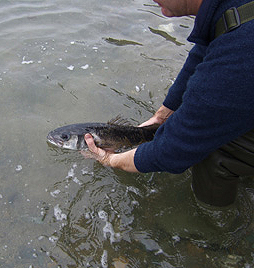 The Irish Fishermen's Organisation has called on Marine Minister Simon Coveney to re-open bass fisheries to commercial fishermen. They have been closed for several years but that may lead to Ireland being excluded forever from fishing bass, while foreign vessels in the EU can catch the fish in Irish waters. The EU has begun a process to put controls on the catching of bass by commercial boats, known as the TAC - Total Allowable Catch. Officials have proposed that this be based on commercial landings of bass over a ten-year period. But Ireland will have no adequate record to claim part of this TAC, so once again the Irish government approach will damage the Irish fishing industry and allow foreign nations to continue catching in Irish waters, while Irish boats cannot. The leisure angling industry demanded and got the ban and has benefited from non-commercial catches. While Irish fishermen are banned from catching bass, foreign boats have targeted the species off the South coast and will be allowed continue, even if a TAC is imposed because they have a catching record. "The Irish Government is again handing national resources to foreign usage," said the commercial fishermen's organisation. Anglers are only allowed to have two bass in their possession in any one 24-hour period and they must be over 40 cm. in total length.
The Irish Fishermen's Organisation has called on Marine Minister Simon Coveney to re-open bass fisheries to commercial fishermen. They have been closed for several years but that may lead to Ireland being excluded forever from fishing bass, while foreign vessels in the EU can catch the fish in Irish waters. The EU has begun a process to put controls on the catching of bass by commercial boats, known as the TAC - Total Allowable Catch. Officials have proposed that this be based on commercial landings of bass over a ten-year period. But Ireland will have no adequate record to claim part of this TAC, so once again the Irish government approach will damage the Irish fishing industry and allow foreign nations to continue catching in Irish waters, while Irish boats cannot. The leisure angling industry demanded and got the ban and has benefited from non-commercial catches. While Irish fishermen are banned from catching bass, foreign boats have targeted the species off the South coast and will be allowed continue, even if a TAC is imposed because they have a catching record. "The Irish Government is again handing national resources to foreign usage," said the commercial fishermen's organisation. Anglers are only allowed to have two bass in their possession in any one 24-hour period and they must be over 40 cm. in total length.
CAN YOU HELP RESOLVE A STICKY SITUATION?
Humans have not managed to create glues that can be used successfully in wet environments, but sea creatures have and Irish marine researchers are trying to find out how they do it. The secrets of the goose barnacle are being sought so that a synthetic version of their natural underwater glue could be used in surgery and dentistry. This barnacle is mostly at sea so examples are difficult to find ashore. Although goose barnacles look like giant shellfish attached to a long neck, they are in fact filter-feeding creatures.They have an ability to attach themselves to practically every surface and researchers have found they can even do so to non-stick frying pans! The glue-like substance they emit, which hardens into a strong "cement", consists of several proteins. Scientists based at the Martin Ryan Marine Institute in Galway hope to study the glands emitting the glue and the protein composition. The team needs a large supply of goose barnacles and has asked for public help from people on the beaches, swimming, surfing and from divers. The barnacles sporadically wash ashore in Summer along the Irish coast. "It might seem perfectly ordinary that a sea creature can stick to a surface, but if you stop to think about it, it's actually quite an incredible innovation by nature," say the researchers. "Humans haven't managed to create glues that can be used successfully in wet environments, but nature has done it over and over again."
TUNNEL BUYS FERRIES – UK GOVERNMENT WANTS TO KNOW WHY

Eurotunnel, the company which operates the Channel Tunnel, has bought three of SeaFrance's former vessels. The move surprised the UK Government where the Office of Fair Trading has launched an investigation to decide whether the purchase is in contravention of merger rules. Eurotunnel Chief Executive Officer Jacques Gounon Jacques Gounon said: "There's an evolution in traffic, notably towards heavy goods vehicles, which can't be fully captured by the Channel Tunnel."
CORK BROTHERS WRAP UP THE 18S IN SCOTLAND
Cork Harbour Monkstown Bay Sailing Club members, brothers Ewen and Colin Barry won nine of the ten trophies up for competition at the National 18 Class Championships in Findhorn in Scotland, a stunning achievement.
Colin is the Club's Rear Commodore and Ewen is Hon.Treasurer. Another MBSC member, Dave O'Connell, a long-time stalwart of the Class was fifth overall in a fleet which included entries from the Scottish host club, from Temasis Yacht Club in London, the Isle of Man YC and the Royal Cork.
Ewen and his crew were sailing 'Good Bad & Ugly' and were top overall boat on nine points, six clear of brother Colin and his crew sailing 'Purple Warriors' on 13 points in second place. They finished on the same number of points as Colin Chapman from the RCYC. A tie-breaker, used in sailing to establish final positions from the best individual race placings, favoured the Monkstown crew. The National 18-foot dinghy has survived several assaults on its popularity, one of which was from the development of the 1720 Class, named after the founding year of the Royal Cork and which it was once thought would replace the 18. That did not happen and, after a surge of popularity, the 1720 declined for a number of years locally though gaining a lot of support internationally. It is now regaining popularity as a sportsboat.
STATE GETS LUSITANIA ITEMS
Items recovered from the last survey of the wreck of the Lusitania have undergone conservation and maintenance in Ireland and been assigned to the State. They include part of the steering mechanism, a bronze telemotor, four portholes, two of them from the first-class passenger area and an indicator used for finding the ship's direction. The items were recovered during the filming of the recently-transmitted National Geographic Channel television documentary. The company sponsored the last survey carried out a year ago.
There have been legal disagreements between American millionaire Greg Bemis who owns the wreck and the State, but there were negotiations involving the National Museum, the National Monuments Service and his representatives after the survey in which Irish maritime archaeologists were involved.
A BAD SUMMER - BUT IT COULD BE WORSE!
It has been a bad summer but history shows that there have been much worse! 1783 for example when there was so much volcanic activity around the world and a fog that lasted most of the summer in England, leading to predictions that it was the end of the world! Between June 23 and July 20 of that year the skies over the UK were covered by a smoky fog and there was regular thunder and lightning which terrified people. There were volcanic eruptions in Italy and Japan and a massive eruption on Skaptar Jokull in Iceland where 9,500 people were reported to have died after being smothered by the immense dust cloud which drifted south and covered much of Europe.
Remember the last Icelandic cloud?
OCEANS ARE SAVING US
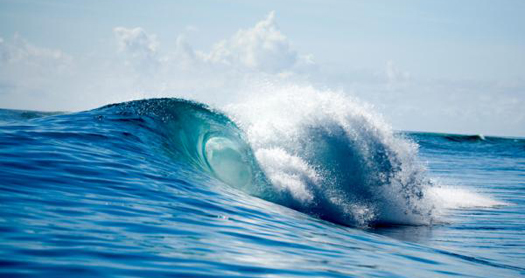
If the oceans were not soaking up carbon dioxide from land, global warming would be much worse. A new report this week shows that industrial production and human living requirements on land are now creating so much carbon dioxide in the atmosphere that the oceans and plants ashore are having to absorb more than twice the amount they previously soaked up. They are the only brake on global warming, but having to absorb so much CO2 is changing seawater, a process called ocean acidification. "This change will have profound effects on life in the ocean and those who depend on it," according to the report from the University of Colorado in the USA which confirms data from the Global Carbon Project, linking scientists around the world. Carbon soaked up from the atmosphere by the seas has risen to 5 billion tonnes. Twenty years ago the figure was 2.4 billion.
Email comments, opinions, information to: [email protected] more marine news and comment on Twitter: @TomMacSweeney
And on Facebook – THIS ISLAND NATION page



























